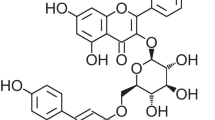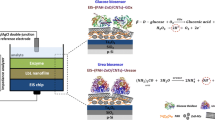Abstract
Carboxylic group-functionalized carbon nanotubes (c-CNT) were modified on the surface of carbon paste electrode to obtain a conducting precursor film. Positively charged poly-l-lysine (pLys) and negatively charged double-stranded DNA (dsDNA) were alternately adsorbed on the c-CNT-modified electrode, forming (pLys/dsDNA) n layer-by-layer (LBL) films. Cyclic voltammetry and electrochemical impedance spectroscopy of the electroactive probe [Fe(CN)6]3−/4− could give the valuable dynamic information of multilayer films growth. The oxidative DNA damage induced by cadmium ion (Cd2+) in the LBL multilayer films was studied by differential pulse voltammetry (DPV) with methylene violet (MV) as the intercalation redox probe. The electrochemical signals of MV on the multilayer films were effectively amplified via LBL technology. The specific intercalation of MV into dsDNA base pairs and the amplified electrochemical response of MV, combined with the unique feature of loading reversibility of MV in the DNA layer-by-layer films, made the difference in DPV response between the intact, and damaged dsDNA films become pronounced. This biosensor exhibited that the (pLys/dsDNA) n films could be utilized for investigations of DNA damage.




Similar content being viewed by others
References
Kato D, Sekioka N, Ueda A, Kurita R, Hirono S, Suzuki K, Niwa O (2008) A nanocarbon film electrode as a platform for exploring DNA methylation. J Am Chem Soc 130:3716–3717
Wang XL, Yang T, Jiao K (2009) Electrochemical sensing the DNA damage in situ induced by a cathodic process based on Fe@Fe2O3 core-shell nanonecklace and Au nanoparticles mimicking metal toxicity pathways in vivo. Biosens Bioelectron 25:668–673
Fojta M (2002) Electrochemical sensors for DNA interactions and damage. Electroanal 14:1449–1463
Fojta M (2004) Mercury electrodes in nucleic acid electrochemistry: sensitive analytical tools and probes of DNA structure. A review. Collect Czechoslov Chem Commun 69:715–747
Fojta M (2005) In: Palecek E, Scheller F, Wang J (eds) Electrochemistry of nucleic acids and proteins. Towards electrochemical sensors for genomics and proteomics. Elsevier, Amsterdam, p 386
Palecek E, Fojta M (2005) In: Wilner I, Katz E (eds) Bioelectronics. Wiley VCH, Weinheim, p 127
Chiti G, Marrazza G, Mascini M (2001) Electrochemical DNA biosensor for environmental monitoring. Anal Chim Acta 427:155–164
Oliveira-Brett AM, Silva LA (2002) A DNA-electrochemical biosensor for screening environmental damage caused by s-triazine derivatives. Anal Bioanal Chem 373:717–723
Ostatna V, Dolinnaya N, Andreev S, Oretskaya T, Wang J, Hianik T (2005) The detection of DNA deamination by electrocatalysis at DNA-modified electrodes. Bioelectrochemistry 67:205–210
Wang B, Rusling JF (2003) Voltammetric sensor for chemical toxicity using [Ru(bpy)2poly(4-vinylpyridine)10Cl)]+ as catalyst in ultrathin films. DNA damage from methylating agents and an enzyme-generated epoxide. Anal Chem 75:4229–4235
Mugweru A, Wang B, Rusling JF (2004) Voltammetric sensor for oxidized DNA using ultrathin films of osmium and ruthenium metallopolymers. Anal Chem 76:5557–5563
Pereira FC, Zanonib MV (2007) Voltammetric sensor for sodium nitroprusside determination in biological fluids using films of poly-L-Lysine. Electroanal 19:993–998
Monterroso SC, Carapuc HM, Duarte AC (2006) Mixed polyelectrolyte coatings on glassy carbon electrodes: ion-exchange, permselectivity properties and analytical application of poly-l-lysine-poly(sodium 4-styrenesulfonate)-coated mercury film electrodes for the detection of trace metals. Talanta 68:1655–1662
Luzr CS, Damosa FS, Tanaka AA, Kubota LT (2006) Dissolved oxygen sensor based on cobalt tetrasulphonated phthalocyanine immobilized in poly-l-lysine film onto glassy carbon electrode. Sensor Actuat B-Chem 114:1019–1027
Zhao JJ, Bradbury C, Huclova S, Potapova I, Carrara M, Fermin DJ (2005) Nanoparticle-mediated electron transfer across ultrathin self-assembled films. J Phys Chem B 109:22985–22994
Kakkassery JJ, Abid JP, Carrara M, Fermin DJ (2004) Electrochemical and optical properties of two dimensional electrostatic assembly of Au nanocrystals. Faraday Discuss 125:157–169
Jiang C, Yang T, Jiao K, Gao HW (2008) A DNA electrochemical sensor with poly-l-lysine/single-walled carbon nanotubes films and its application for the highly sensitive EIS detection of PAT gene fragment and PCR amplification of NOS gene. Electrochim Acta 53:2917–2924
Hason S, Dvorak J, Jelen F, Vetterl V (2002) Impedance analysis of DNA and DNA–drug interactions on thin mercury film electrodes. Crit Rev Anal Chem 32:167–179
Hason S, Dvorak J, Jelen F, Vetterl V (2002) Interaction of DNA with echinomycin at the mercury electrode surface as detected by impedance and chronopotentiometric measurements. Talanta 56:905–913
Jelen F, Erdem A, Palecek E (2000) Cyclic voltammetry of echinomycin and its complexes with DNA. J Biomol Struct Dyn 17:1176–1177
Jelen F, Erdem A, Palecek E (2002) Cyclic voltammetry of echinomycin and its interaction with double-stranded and single-stranded DNA adsorbed at the electrode. Bioelectrochemistry 55:165–167
Karadeniz H, Gulmez B, Erdem A, Jelen F, Ozsoz M, Palecek E (2006) Echinomycin and cobalt-phenanthroline as redox indicators of DNA hybridization at gold electrodes. Front Biosci 11:1870–1877
Xie JK, Jiao K, Liu H, Wang QX, Liu SF, FU X (2008) DNA electrochemical sensor based on PbSe nanoparticle for the sensitive detection of CaMV35S gene sequence. Chin J Anal Chem 36:874–878
Zhao YD, Pang DW, Wang ZL, Cheng JK, Qi YP (1997) DNA-modified electrodes. Part 2. Electrochemical characterization of gold electrodes modified with DNA. J Electroanal Chem 431:203–209
Zhang Y, Hu NF (2007) Cyclic voltammetric detection of chemical DNA damage induced by styrene oxide in natural dsDNA layer-by-layer films using methylene blue as electroactive probe. Electrochem Commun 9:35–41
Anas A, Akita H, Harashima H, Itoh T, Ishikawa M, Biju V (2008) Photosensitized breakage and damage of DNA by CdSe–ZnS quantum dots. J Phys Chem B 112:10005–10011
Huang JY, Li T, Chen ZY, Liu XJ, Liu SL (2008) Rapid electrochemical detection of DNA damage and repair with epigallocatechin gallate, chlorogenic acid and ascorbic acid. Electrochem Commun 10:1198–1200
Lin AJ, Zhang XH, Chen MM, Cao Q (2007) Oxidative stress and DNA damages induced by cadmium accumulation. J Environ Sci 19:596–602
Acknowledgments
This project was supported by the National Natural Science Foundation of China (nos. 20635020, 20805025, and 20975057), Doctoral Foundation of the Ministry of Education of China (no. 20060426001), and the Natural Science Foundation of Qingdao City (no. 09-1-3-25-jch).
Author information
Authors and Affiliations
Corresponding author
Rights and permissions
About this article
Cite this article
Du, M., Yang, T. & Jiao, K. Carbon nanotubes/(pLys/dsDNA) n layer-by-layer multilayer films for electrochemical studies of DNA damage. J Solid State Electrochem 14, 2261–2266 (2010). https://doi.org/10.1007/s10008-010-1059-z
Received:
Revised:
Accepted:
Published:
Issue Date:
DOI: https://doi.org/10.1007/s10008-010-1059-z




